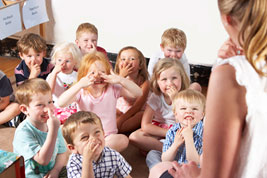Possible educational effects of hearing loss
My child is now old enough to be starting school. How might his hearing loss affect his education? What should I know before I meet with the school team? How will I know what to ask for?
Possible effects on learning: Relationship of Hearing Loss to Listening and Learning Needs – 1 hearing loss per page (parent/teacher version) summarizes the potential effects of hearing loss on a child’s perception of speech in a school setting and possible need for educational supports. Spanish version. Nine different hearing losses are described. Select the handout that represents the range of hearing loss of your child.
If your child has different hearing loss levels in each ear, choose the handout that is the same as his better hearing ear. These handouts may be useful in advocating for services with the student’s school staff or medical staff.
- 16-25 dB
- 26-40 dB
- 41-55 dB
- 56-70 dB
- 71-90 dB and 91+dB
- high frequency hearing loss
- reverse slope or mid-frequency (cookie bite) hearing loss
- unilateral hearing loss
- fluctuating hearing loss (ear infections)
The dB levels of hearing loss are used because the terms minimal (16-25 dB), mild (26-40 dB) and moderate (41-55 dB) hearing loss do not match the seriousness of these hearing losses regarding child development, listening and learning.
Listening challenges at home – helpful information to share with school! Children’s Home Inventory of Listening Difficulties (CHILD) – This is a tool that families can compl ete for children as young as age 3. By rating your child’s listening behaviors for various situations you are identifying different settings in which he or she may have challenges.
ete for children as young as age 3. By rating your child’s listening behaviors for various situations you are identifying different settings in which he or she may have challenges.
This information can be useful for transitioning into school (see Starting School LIFE below) or may help families understand how their communication patterns may need to change to encourage the child to become an assertive communicator.
It may also help identify needs for assistive devices in the home.
Families have important information to share with school teams when children start school! Starting School LIFE (Listening Inventory For Education) – This tool records the valuable information from the family’s completion of the CHILD, along their observations of their child as a communication partner and their level of independence.
It combines this information with results of the school’s eligibility assessment or annual assessment. The gathered information provides important insights into the child’s communication strengths and listening needs for consideration of potential placement, classroom accommodations or skill building needs.
Adapting the learning environment to support the learner with hearing loss: Children with Hearing Loss – Helpful Adaptations in the School Environment – Listening and learning in the classroom can be very challenging for students with hearing loss. This information provides an overview of classroom accommodations and expectations that the school team can address to meet these needs.
Learning check-up for preschoolers: Preschool SIFTER – This is an assessment that is typically completed by the classroom teacher at the request of the hearing professional on the school staff. It provides a quick screening of the child’s functional ability as compared to typically developing age peers (class peers for kindergarten) in the areas of Pre-academics, Attention, Communication, Class Participation, and Social Behavior.
typically completed by the classroom teacher at the request of the hearing professional on the school staff. It provides a quick screening of the child’s functional ability as compared to typically developing age peers (class peers for kindergarten) in the areas of Pre-academics, Attention, Communication, Class Participation, and Social Behavior.
There is a scoring grid that rates the child as typical or at-risk for Communication or Social Behavior in each of these areas. This functional monitoring can be highly effective in the fall (i.e., October), mid-year (i.e., January) and end (i.e., May) of each school year. The final Preschool SIFTER (in Spanish) can be used to provide insights to the child’s new teacher in the following fall. Family members can share this tool with their child’s school team as a means of monitoring his or her performance throughout the school year.
